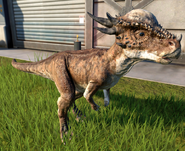Stygimoloch is an unlockable dinosaur in Jurassic World Evolution added in the Fallen Kingdom DLC.
Information[]
Stygimoloch fossils are unlocked once the player ___.
Base Stats (at 100% Genome)[] | |
|---|---|
| Attack | 34 |
| Defense | 18 |
| Lifespan | 88 |
| Resilience | 39 |
| Rating | 36 |
| Incubation Cost | $188,000 |
Dig Sites[]
- Hell Creek Formation
Skins[]
- Rainforest Pattern
- Steppe Pattern
- Arid Pattern
- Wetland Pattern
- Coastal Pattern
Genome[]
Stygimoloch has 9 Gap ID slots to modify.
- Cosmetic
- Defense
- Lifespan
- Resilience
- Habitat
- Stress
- Lifespan
- Social
- Defense
Bio[]
Profile[]
- Stygimoloch eats small amounts from ground herbivore feeders.
- They live in moderate social groups to avoid predation and also prefer to have a variety of other dinosaurs nearby.
- They like good sized open grassland areas with a slightly smaller coverage of forest.
- They are vulnerable to most predators, but can defend themselves from small carnivores.
Classification[] | |
|---|---|
| Small Herbivore | |
Health Requirement[] | |
| Appetite | 51 |
| Metabolism | 2.69 |
Comfort Requirement[] | |
| Comfort Threshold | 25% |
| Grassland | 8,200 m2 |
| Forest | 4,900 m2 |
| Wetland | 0 m2 |
| Ideal Population | 2 - 14 |
| Social Group | 4 - 12 |
Disease[] | |
| Susceptible | Campylobacter |
| Immune | N/A |
Food Preference[] | |
| Primary Preference | Horsetails |
| Secondary Preference | Grasses |
| Cycads | |
| Harmed By: | Tree Ferns |
| Conifers | |
| Ginkgo | |
InGen Database[]
Stats[] | |
|---|---|
| Era | Late Cretaceous |
| Family | Pachycephalosauridae |
| Genus | Stygimoloch |
| Height | 1.1 m |
| Weight | 78 kg |
| Length | 3.5 m |
| Feeder Type |
Ground Herbivore |
Description[]
- Stygimoloch was a pachycephalosaurid dinosaur. Its name means "Styx devil", referring to the river from Greek mythology that bounds the underworld.
- It had a smaller, flatter dome than other pachycephalosaurids, with more elaborate spikes around the skull.
Discovery[]
- Stygimoloch is currently known from the Hell Creek, Ferris and Lance Formations, where only juvenile specimens have been discovered.
Paleoecology[]
- Stygimoloch fossils have been found in regions known to be subtropical along the shoreline of the Western Interior Sea. There was no cold season, and steady amounts of rainfall buried specimens under layers of sand after they were washed downstream.


